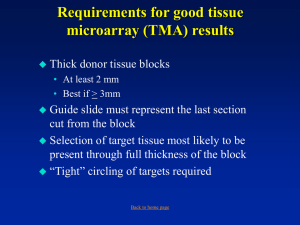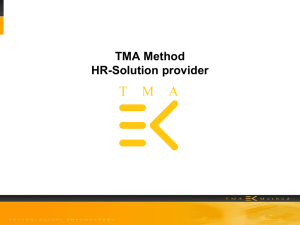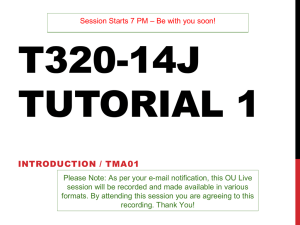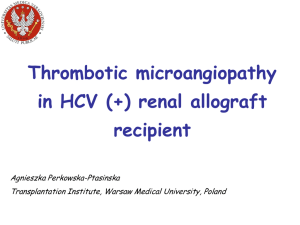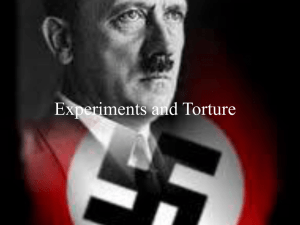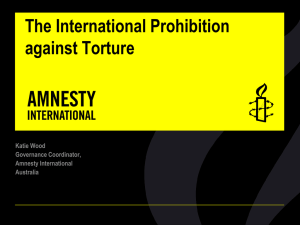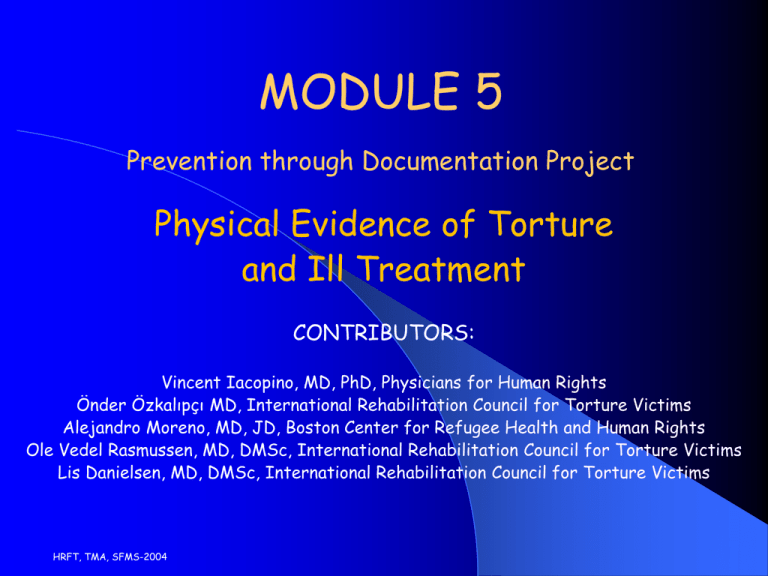
MODULE 5
Prevention through Documentation Project
Physical Evidence of Torture
and Ill Treatment
CONTRIBUTORS:
Vincent Iacopino, MD, PhD, Physicians for Human Rights
Önder Özkalıpçı MD, International Rehabilitation Council for Torture Victims
Alejandro Moreno, MD, JD, Boston Center for Refugee Health and Human Rights
Ole Vedel Rasmussen, MD, DMSc, International Rehabilitation Council for Torture Victims
Lis Danielsen, MD, DMSc, International Rehabilitation Council for Torture Victims
HRFT, TMA, SFMS-2004
Module 5 Outline
Physical Evidence of Torture
Medical History
The Physical Examination
Diagnostic Tests
HRFT, TMA, SFMS-2004
Physical Evidence of Torture
Medical evaluation :
– for legal purposes should be objectivie and impartia l
– should be based on physician’s clinical expertise and
professional experience
Clinicians who conduct evaluations of detainees should have
specific essential training in forensic documentation of torture
and other forms of abuse
Detailed account of patient’s observations of acute lesions and
subsequent healing process often represent important source of
evidence in corroborating specific allegations of torture or illtreatment
HRFT, TMA, SFMS-2004
Physical Evidence of Torture
Absence of physical evidence does not mean torture
did not occur:
– Noted in Istanbul Protocol
– Such acts might not leave marks or permanent scars
Clinicians should have knowledge of
prison conditions
– torture methods used in the particular region of
imprisonment
– common after-effects of torture
–
Clinicians should not assume that official requesting
medical-legal evaluation has related all material facts
HRFT, TMA, SFMS-2004
Medical History
Obtain a complete medical history: prior medical,
surgical or psychiatric problems , details of torture,
acute and chronic symptoms
Document any history of injuries before period of
detention and any possible aftereffects
Avoid leading questions
Structure inquiries to elicit an open-ended,
chronological account of events experienced during
detention
HRFT, TMA, SFMS-2004
Medical History
Specific historical information may be useful
in correlating regional practices of torture
with individual allegations of abuse
– descriptions of torture devices
– body positions
– methods of restraint
– descriptions of acute or chronic wounds and
disabilities
– identifying information about perpetrators and
places of detention
HRFT, TMA, SFMS-2004
Medical History
Acute Symptoms
– Types of symptoms (i.e. bleeding, bruising, swelling,
–
–
–
–
–
open wounds, lacerations, fractures, dislocations,
pain, numbness)
Intensity, frequency & duration of each symptom
Development of any subsequent skin lesions or
scars
Health condition on release
Description of healing process
Details of any medical treatment
HRFT, TMA, SFMS-2004
Medical History
Chronic Symptoms:
– Elicit information about physical ailments that individual believes
were associated with torture
– Make note of:
severity, frequency, duration of each symptom
associated disability
need for medical or psychological care
– Common somatic complaints include headache, back pain,
gastrointestinal symptoms, sexual dysfunction and muscle pain.
– Common psychological symptoms include depressive affect, anxiety,
insomnia, nightmares, flashbacks and memory difficulties
HRFT, TMA, SFMS-2004
The Physical Examination
– Dermatologic Evaluation
– Head and neck
– Eyes, Ears, Nose
– Jaw, Oropharynx and Teeth
– Chest and Abdomen
– Musculoskeletal System
– Neurologic Examination
– Examination of Women
– Genital Examination of Men
– Perianal Examination
– Medical Photography
– Assessment for Referral
HRFT, TMA, SFMS-2004
Dermatologic Evaluation
Description of skin lesions should include:
– Localisation (use body diagram): symmetrical, asymmetrical
– Shape: round, oval, linear, circumferential, etc
– Size: (use ruler)
– Colour
– Surface: scaly, crusty, ulcerative, bullous, necrotic
– Periphery: regular or irregular, zone in the periphery
– Demarcation: sharply, poorly
– Level in relation to surrounding skin: atrophic, hypertrophic,
macular
HRFT, TMA, SFMS-2004
Dermatologic Evaluation
Common injuries to the skin can be
classified as :
– Abrasions (or grazes)
– Contusions (commonly known as bruises)
– Lacerations (also, commonly but
confusingly, known as cuts)
– Incisions (including stab wounds)
– Burns and scalds
HRFT, TMA, SFMS-2004
Abrasions
HRFT, TMA, SFMS-2004
Contusions
HRFT, TMA, SFMS-2004
Contusions
HRFT, TMA, SFMS-2004
Contusions
HRFT, TMA, SFMS-2004
Lacerations
Caused by tangential force such as a blow or a fall and
produce tears of the skin
Wound edges tend to be irregular and may be bruised or/and
abraded
There might be tissue bridges (where the skin has not
separated along the entire length of the wound).
Develop easily on the protruding parts of body because skin
is compressed between blunt object and bone surface under
subdermal tissues
HRFT, TMA, SFMS-2004
Incisions
HRFT, TMA, SFMS-2004
Burns & Scalds
HRFT, TMA, SFMS-2004
Burns & Scalds
HRFT, TMA, SFMS-2004
Burns & Scalds
HRFT, TMA, SFMS-2004
Burns & Scalds
HRFT, TMA, SFMS-2004
Complex Lesions
Injuries can result in different types of
wounds :
– example: wounds caused by broken glass may be
mixture of incision and laceration
– example: human bites tend to be mixture of
laceration and crush injury with or with out
petechiae from sucking
HRFT, TMA, SFMS-2004
Scarring
Most common late physical finding
Healing influenced and often impaired by many factors i.e.:
– persistent, untreated infection
– repeated trauma to the same area
– malnutrition
Healing by primary intention: top down, small scar
Healing by secondary intention: from below, wide “biconvex”
scar, gaping edges, prone to infection
Self-inflicted: usually using dominant hand to accessible
parts of the body, not severe
HRFT, TMA, SFMS-2004
Scarring
Keloid scars:
– exceed the boundaries of the original wound
Post-inflammatory hyperpigmentation
– can follow inflammation in darker skins, irrespective of
cause
– retains the shape of the original inflammation
classic tramline bruising can leave distinctive patterns
of hyperpigmentation (usually 5-10 yrs)
whipping can sometimes leave lines of
hyperpigmentation, especially in darker skin (rarely
confused with striae distensae)
tight ropes or handcuffs may leave hyperpigmented
circumferential scars due to marks around wrists, and
marks following
HRFT, TMA, SFMS-2004
Striae distensae
HRFT, TMA, SFMS-2004
Head & Neck
Most traumatic scars on the face tend to be relatively small
and may be difficult to distinguish from disease processes
Lesions are common over bony points, especially the
eyebrows and the cheekbones and may be associated with
fractures
Broken or missing teeth are commonly observed
Petechiae of the palate may be evidence of forced oral
intercourse
Slaps to the ear can sometimes rupture the eardrum
HRFT, TMA, SFMS-2004
Eyes
Findings may include:
– Conjunctival hemorrhage
– Lens dislocation
– Subhyeloid hemorrhage,
– Retrobulbar hemorrhage
– Retinal hemorrhage
– Visual field loss
– Lacerations (caused by a tangential force such as a blow
or a fall and produce tears of the skin)
Referral to an ophthalmologist is recommended
whenever there is a suspicion of ocular trauma or
disease
HRFT, TMA, SFMS-2004
Ears
Findings may include:
– External haematoma
– Cartilage necrosis and infection
– Rupture of tympanic membrane
– Hearing loss
– Vertigo
– Tinnitus
– Disequilibrium
– Facial nerve paralysis
Audiogram recommended for middle/inner ear injuries
MRI for signs of skull fracture
HRFT, TMA, SFMS-2004
Nose
Evaluate for alignment, crepitation, and deviation of nasal
septum
Deviation of nasal septum may result in nasal obstruction
For simple nasal fractures, standard nasal radiographs
should be sufficient
For complex nasal fractures and when the cartilaginous
septum is displaced, and when rhinorrhea is present, CT
and/or MRI are recommended
HRFT, TMA, SFMS-2004
Jaw, Oropharynx & Teeth
During application of electric current to the mouth, tongue,
gingiva or lips may be bitten. Lesions might also be produced
by forcing objects or materials into the mouth
Refer to a dentist if there is any damage to the teeth
Mandibular fractures, avulsions or fractures of teeth, broken
prostheses, swelling of the gums, bleeding, pain, or loss of
fillings from teeth can all result from direct trauma or
electric shock torture
X-rays and MRI are suggested for determining extent of soft
tissue, mandibular and dental trauma
HRFT, TMA, SFMS-2004
Chest & Abdomen
Rib fractures are frequent consequence of beatings to chest. If displaced,
may be associated with lacerations of lung and possible pneumothorax.
Fractures of vertebral pedicles may result from direct blunt force.
Fractures of lower right ribs carry approximately 10% risk of hepatic injury
Examiner must consider possibility of intramuscular, retroperitoneal and
intra-abdominal hematomas, as well as laceration or rupture of an internal
organ
Ultrasonography, CT scans and bone scintigraphy should be used, when
available, to confirm such injuries
Gross haematuria is most significant indication of kidney contusion
Renal failure due to crush syndrome may be seen acutely following severe
beatings
HRFT, TMA, SFMS-2004
Musculoskeletal System
Musculoskeletal complaints very common
May result from beatings, suspension, or other positional torture or
may also be somatic
Physical examination of skeleton should include testing for mobility of
joints, spine and extremities, pain with motion, contractures, strength,
evidence of compartment syndrome, fractures with or without
deformity, and dislocations
Evaluate for trauma to muscle such as muscle rupture and muscle
tearing.
Specific clinical signs of ligament tear include swelling, bruising, muscle
spasm, and painful stress test, often with joint laxity. May be palpable
gap in the ligament. If completely torn, then considerable swelling and
bruising occurs. Tendon ruptures, avulsions from insertion of bone.
HRFT, TMA, SFMS-2004
Neurological Examination
Evaluate CNS and PNS for :
– Neuropathies (i.e. brachial plexus from suspension)
– Cranial nerve deficits
– Hyperalgesia
– Parasthesiae
– Hyperaesthesia
– Change in position and temperature sense
– Sensation & motor function
– Gait and coordination
Head trauma is common
– Scalp injuries
– Brain injury and seizures
Headaches: evaluate structural vs. psychosomatic
HRFT, TMA, SFMS-2004
Examination of Women
Must seek specific consent
– Give clear, unambiguous explanation of reason for genital
examination while alleged victim is fully clothed
– Note observations about patient’s demeanour
Examination Following a Recent Assault
– Rare that victim of rape during torture is released while still
possible to identify acute signs of assault
– Whenever possible, examination should be performed by an expert
in documenting sexual assault
– Chaperone if physician is of a different gender
– cutaneous lesions: contusions, lacerations, abrasions, ecchymoses
and petechiae from sucking or biting
– Note: Genital lesions observed in < 50% of rape cases
– Use rape kit (STD, pregnancy, DNA tests)
– STD treatments and prophylaxis
HRFT, TMA, SFMS-2004
Examination of Women
Examination after immediate phase
– If alleged assault occurred more than a week earlier and tno
signs of bruises or lacerations, then less immediacy to
conduct pelvic examination
In this setting rare to find physical evidence
Still beneficial to photograph any residual lesions
– Diagnostic findings are not likely in women who have
delivered babies prior to the rape
– Assessment and treatment for STDs: i.e. gonorrhoea,
chlamydia, syphilis, HIV, hepatitis B and C, herpes simplex
and Condyloma acuminatum (venereal warts), vulvovaginitis
associated with sexual abuse, such as trichomoniasis,
Moniliasis vaginitis, Gardnerella vaginitis and Enterobius
vermicularis (pinworms), as well as urinary tract infections
HRFT, TMA, SFMS-2004
Genital Examination of Men
Crushing/squeezing of the scrotum: may observe hyperaemia,
marked swelling and ecchymosis
Scrotal mass differential:
– Hydrocele (fluid in tunica vaginalis, transilluminates)
– Haematocele (blood in tunica vaginalis, does NOT
transilluminate)
– Inguinal hernia (cannot palpate the spermatic cord above the
mass)
Testicular torsion - a surgical emergency
Erectile dysfunction - often psychosomatic
Assess for sexually transmitted diseases, Hepatitis B and HIV and
prophylaxis
HRFT, TMA, SFMS-2004
Perianal Examination
After anal rape or insertion of objects into the anus of
either gender, pain and bleeding can occur for days or weeks
– If bleeding persists, may mean scarring of rectal mucosa,
can be seen by proctoscopy
Lacerations are caused by a tangential force such as a blow
or a fall and produce tears of the skin
Follow protocols for STDs
If there is any possibility of the perpetrator being
prosecuted, air dried internal and external anal swabs can be
taken up to five days after the rape and stored for DNA
testing, even if the survivor has defecated
HRFT, TMA, SFMS-2004
Medical Photography
Document injuries as quickly as possible, before any
change occurs
Any photographic equipment can be used initially and
more professional photographs can be taken later
Forensic photos should :
– Show current date (digital or newspaper in photo)
– Identity of alleged victim (face)
– Show scale (ruler or common object)
– Use natural lighting instead of flash
– Follow chain of custody
HRFT, TMA, SFMS-2004
Assessment for Referral
Those who need further medical and/or
psychological care should be referred to
appropriate services
– If rehabilitation centre for torture survivors in
the region, contact for further support or
advice
– In countries systematic torture and pressure
on health care professionals the examining
clinician may also want to refer patients to
specialists to increase number of medical
witnesses to torture
HRFT, TMA, SFMS-2004
Diagnostic Tests
Diagnostic tests may aid in corroborating
allegations of torutre
Before obtaining such tests,consider
– potential value of tests
– inherent limitations in light of the level of “proof”
needed in a particular case
– potential adverse consequences for individual
– resource limitations
Generally, not warranted unless likely to make a
significant difference to a medical-legal case
HRFT, TMA, SFMS-2004
Radiologic Imaging
X-Rays
– Readily available
– Can be very useful when searching for fractures,
fissures, deformity and foreign bodies in osseous
structures
– When periosteal damage or minimal fractures are
suspected, bone scintigraphy should be used in addition t
– Soft tissue changes adjacent to fracture or deformity as
well as foreign bodies in vicinity can contribute
information
– Percentage of x-rays will be negative even when there is
an acute fracture or early osteomyelitis
HRFT, TMA, SFMS-2004
Radiologic Imaging
Scintigraphy
– High sensitivity but low specificity
– Economic and effective examination to screen entire
skeleton for disease processes such as osteomyelitis,
trauma, testicular torsion
– Scintigraphy can detect an acute fracture within twentyfour hours, but generally it takes two to three days and
may occasionally take a week or more
– Generally scan returns to normal after two years but may
remain positive in both fractures and cured osteomyelitis
for years
– Often used to detect evidence of falanga and multiple
skeletal injuries
HRFT, TMA, SFMS-2004
Radiologic Imaging
Ultrasound
– Inexpensive and without biologic hazard
– Primarily used for evaluation of muscles and joints, especially
shoulder joint, but can be more useful for contributions
depending on skill of applicator administering it
– At present high channel probes with multifrequencies (8-15
MHz) can be more sensitive than CT and MRI in showing
changes in cutaneous, subcutaneous, osseous, soft tissues,
muscles and joints
– Sensitivity to pathology related to shoulder, knee and ankle
joints and related lesions of joints, tendons and adjacent soft
tissues is usually higher than MRI
– Doppler studies: may demonstrate focal deficits of tissue
perfusion and areas of reactive hyperaemia can be identified
in injuries
HRFT, TMA, SFMS-2004
Radiologic Imaging
CT scans
– Excellent for
imaging both soft tissue and bone
diagnosing and evaluating fractures, especially
temporal bone and facial bones
– CT with and without intravenous infusion of a contrast
agent should be the initial examination for acute,
subacute and chronic central nervous system lesions. If
negative, equivocal or does not explain the survivor’s CNS
complaints or symptoms, proceed to an MRI
– When CSF rhinorrhea is suspected, CT of the face with
soft tissue and bone windows should be performed. Then
CT should be obtained after contrast is injected into the
spinal canal
HRFT, TMA, SFMS-2004
Radiologic Imaging
MRI
– More sensitive than CT in detecting central nervous
system (CNS) abnormalities
– Time course of CNS hemorrhage has ranges that
correlate with imaging characteristics of the
hemorrhage. Thus, imaging findings may allow estimation
of timing of head injury and correlation to alleged
incidents
– MRI with Turbo STIR sequences, directed to whole body
can demonstrate general body trauma and identify
lesions and areas needing detailed evaluation. Minimal
changes identified as bone bruise in pre-oedema stages
can also be identified in osseous tissues within hours of
traumatic injuries
HRFT, TMA, SFMS-2004
Biopsy for Electric Shock Injury
Electric shock injuries can may exhibit microscopic changes that
are highly diagnostic and specific for electric current trauma
Absence of these findings does not mitigate diagnosis of electric
shock torture, and judicial authorities must not be permitted to
make this assumption
Thus procedure currently be done in a clinical research setting only,
not a diagnostic standard
Individuals must be informed of the uncertainty of the results and
permitted to weigh the potential benefit against the impact upon an
already traumatized psyche
Diagnostic findings for electrical injury include:
– Vesicular nuclei in epidermis, sweat glands and vessel walls
– Deposits of calcium salts distinctly located on collagen and
elastic fibers
HRFT, TMA, SFMS-2004
Microscopic Dermatological
Findings After Alleged Torture
HRFT, TMA, SFMS-2004
Microscopic Dermatological
Findings After Alleged Torture
HRFT, TMA, SFMS-2004
Microscopic Dermatological
Findings After Alleged Torture
HRFT, TMA, SFMS-2004

